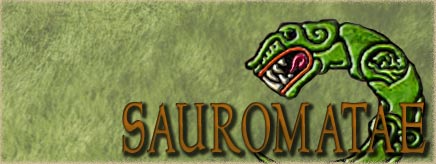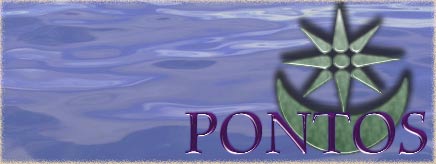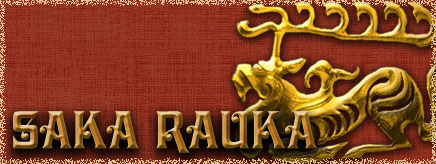Province: Galatia
Traveller's Log
Crossing the river Sangarios the traveller enters one of the oldest countries, which at the same time is the newest. This is Phrygia Megale, where Midas himself ruled in days past, but now the land is called Galatia. The first territory encountered is that of the temple estate of Pessinous by Mount Dindymos. It belongs to the Tolistobogioi, here Galatai and Phryges together venerate the Great Mother of the Mountain Agdistis, but it also serves as an emporion. To the North-East at the fording of the Sangarios stands Uindia another temple estate to the moon deity Deios Uindieinos. Near the eastern riverbank, overlooked by the Galatian Mount Olympos to the East, stands Gordion. The ancient Phrygian seat of power, which the Tolistobogioi and Phryges are rebuilding into their new capital. Next the land is dotted by fortresses, one of the most important is Petrobrogen controlling the main road to Bithynia. While to the North the country has a mountainous nature, marking the boundary with Mariandynia and is protected by the fortress of Souolibrogen. This is also where the domain of the Tektosages begins, stretching from Mount Olympos to the Halys River. Several villages lay near the fertile riverbanks, noteworthy of the area is a sanctuary to Deios Boussourigios. This is the Anatolian deity of heaven, weather and mountains. While the fortress of Ekkobriga controls the main road to Kappadokia. To the South stands Ankyra, another ancient Phrygian settlement, now the capital of the Tektosages. Farther southwards the country becomes a dry plain, bearing the name of Morimene. A hard place to live in, but it is contested for it controls Lake Tatta and is a rich source of salt. Somewhere in the mountains and forests, between Gordion and Ankyra, the most revered place in Galatia is located. Named Drunemeton, this is a sacred oak grove, where the Galatai meet in assembly to decide the common affairs of their confederation. East of the Halys River instead lays the land of the Trokmoi, which used to be part of Kappadokia and is called Chamanene. Legend has it, this was the homeland of a formidable empire. In fact no Phryges live here and the locals rarely receive gifts from the temple estates. However the Trokmoi are not preoccupied by this, indeed it is argued they are the most powerful warriors. Their walled capital, Taouion, is a formidable place. Emphasised by its sanctuary to Deios Taouianos, housing the god's colossal bronze statue and its precinct where anyone is granted asylum.
Geography
Galatia is a vast plateau, bounded by deciduous forests, two river plains and dry grassland. The fluvial reservoirs form several pools, making the land extremely fertile. Meadows and grazing land are also common, as are forests, which have allowed the development of various ecosystems, resulting in spectacular biodiversity. Wild boars, ibexes, red and roe deers, lynxes, gray wolves, brown bears, leopards, asiatic cheetahs and lions, to name a few, turned this region in something of a hunting paradise. Indeed since the early Iron Age this plateau housed several hunting estates and the various species, many now extinct, are still dwindling in number today. Summers are hot and dry in Galatia, but rainy springs and autumns keep the country watered and fertile. Winters are snowy and cold, but the southern plains are unaffected by all of this.
The People, Society and Government
The Galatai were no unified ethnic group, but rather kin groups carrying different tribal identities coalesced by an aristocratic and religious class that conveyed traditions, bearing identity to the various clans. Before crossing the Bosporos, the allied tribes of the Tolistobogioi, Tektosages and Trokmoi had seventeen prominent leaders, following the two most eminent figures among them. Indeed the name Galatai was the self-designation for specialized warrior bands, exerting military and diplomatic pressure as advance guards for colonial enterprises. A characteristic Galatian practice was the Trimarkisia, units of three cavalrymen forming a contingent capable of protracted military engagements, whereby one of the riders was always fighting and could be replaced by the two reserves. When treating with their defeated foes, the Galatai preferred to take captives for ransoms, or held hostages to secure the compliance by the opposing communities. However all of these activities were subordinated to the primary goal of settling into new land. Galatai bands were in fact disproportionally comprised of armed men, suggesting a lower standing in the original community. These 'younger sons' would then join forces in search of new tracks of land to farm, something unavailable in their homelands. Their greatest quality was the readiness to accept foreigners, often towards a mutual social advancement, under Galatian leadership. Integration resolved in the synthesis of new identities and took place in just one or two generations. The tribes established mutual friendship and hospitality not only between themselves, but also with foreign polities and these principles were of the utmost importance in Galatian society. It has been argued that around 25,000 or 30,000 Galatai crossed to Mikra Asia, but subsequent casualties and hiring by Hellenistic Basileis thinned that number considerably. The survivors finally settled in the Phrygian plateau and began that process of territorial acculturation. Indeed the Galatai encountered an autochthonous population that vastly outnumbered them, who was nonetheless willing to accept the newcomers. No lasting political centre had existed in the region for centuries and the people quickly re-shaped the tribes into a larger society. Which took over a large number of villages, surrounding major centres, where a prosperous agricultural structure provided a great variety of products. While traditional routes created a well-connected area of economic importance, that the Galatian warrior class could protect. This was a testament to the well-developed hierarchical Galatian system, that forged in little time a system of values shared by the whole population. The Phrygian priest-states, remnants of the previous political structure, were democratically split between Phryges and Galatai. Common codes and traditions were accepted right away, focused on rituals that offered the new self-representation for the people. Galatian, Luwian and Phrygian names are attested in the same social circles and communities, even mixed in the same families. These identities grew into a completely new Anatolian supra-ethnicity, which employed extravagant architecture for graves and fortifications. The latters located on strategic hilltops possessing dry-stone walls, with carefully protected gateways, projecting towers and other sophisticated defensive features. These were not simply strongholds, but kernels of important agricultural settlements and field systems. Econo-political centres were also built, with large public buildings and workshops, which saw the introduction of new tools. Otherwise the everyday life was predominantly influence by the Luwian and Phrygian population: from the housing and building styles, or methods of storage, to kitchenware. While the new elite adopted an Hellenistic life-style with extravagant graves, imported fine ware and luxury goods. Politically the three tribes, which kept their names, had four constituting groups each and these had four officials per group. They were called Tetrarchai, one served as a judge, another as the military commander and the last two as his subordinates. However the power of these twelve was not absolute, at Drunemeton a council of 300 men assembled and decided all major cases, leaving the others to the council of the Tetrarchai. Initially the Galatai were described as furious and arrogant tall men, with reddish hair. Capable of all sorts of atrocities. An image true for anyone involved in warfare. Although the Galatai did perform human sacrifices until the mid-2nd century BCE, described as offering to the gods of the most handsome prisoners, crowned with garlands, in the full bloom of their lives. Dated from the same period are surviving letters from Eumenes II of Pergamon, to Galatai settlers granting their community the status of polis. The fact is the inhabitants had already received such status from Antiochos III Megas and where now demanding Pergamene recognition. These Galatai definitely appreciated Hellenistic institutions, indeed independent Galatian communities during the 1st century BCE, had become so 'unkeltic' that they came to be known as Gallograeci. For outsiders they were just locals from Anatolia, who acted like Galatai. The Galatian synthesis had been so pervasive that all the Phrygian and Hittite foundations were unquestionably attributed to the Galatai. For the inhabitants of Galatia, there was no difference in such terms, they all described the very same people.
History
Galatia, before acquiring any boundary, was born as a contract in 278 BCE. Nikomedes I of Bithynia had established a Symmachia with Herakleia Pontika, Byzantion, Chalkedon, Kieros and Tieion. So that the parties involved would mutually assist eachother to protect their independence. However facing a claimant brother, holding half of his territory, and none other than Antiochos I of the Arche Seleukeia, Nikomedes I resolved to hire some Galatai. Such a group of warbands, under the chieftains Lonnorios and Lutarios, was marching against Byzantion. But the Bithynian Basileus approached them and reached an agreement: the Galatai would always be friendly towards Nikomedes and his descendants. They would not ally with others without his approval, but have his same enemies and friends. They would also join the Symmachia and help any member requiring assistance. Otherwise spoils of war and territory of their mutual enemies were theirs for the taking. At this point the tribes split their respective areas: the Trokmoi would take the Troas, the Tolistobogioi Aiolis and Ionia, while the Tektosages would fight Nikomedes' brother and take the hinterland. Thus Galatia came to be in theory, now it had to be made into a reality. The raids were incredibly successful: Bithynia was united under Nikomedes' rule, while ransoms were exacted from the people of Mysia and Ionia. Unfortunately most places proved to be poor choices for settlements, being either too exposed, difficult to assault or lacking enough arable land. However beyond the Sangarios River, there was a plentiful countryside, whose population offered little resistance. Phrygia Megale, since the 7th century BCE, had been relegated into being either a borderland or simply traversed by the Royal Road. But from the 4th century BCE constant wars plagued the inhabitants. Local Persian dynasts fought one another for personal gains, then Alexandros III of Makedonia skipped Phrygia Megale altogether. Rendering its roads insignificant and moving all the lucrative traffic to the Southern Highway by the Tauros Mountains. Then in 322 BCE Makedonian invaders plundered the land and levied men to fight in their civil wars. This condition went on for the next 43 years, when Galatai encroached the countryside. These newcomers were not after manpower, but actually offered to protect themselves what was to become the common land of all. With such premises, accepting a new military aristocracy controlling the agricultural production was not a disaster. Nor was there anyone capable of preventing the Galatai from settling there. Only around 275 BCE did such a figure present itself: Antiochos I had arrived with an army poised to reaffirm Seleukid suzerainty in Mikra Asia. Thanks to war elephants Antiochos I defeated the Galatai with ease, assumed the title Soter (saviour), but let the invaders be in what had become Galatia. This was his decision, because a cultural phenomenon had taken place. It had been since the 5th century BCE that the Hellenes faced a common foreign enemy, following the wars with Pârsa. After that only infighting between Hellenic poleis and koina, often siding with Persian authorities took place. Philippos II of Makedonia had succeeded in coercing the Hellenes into fighting together and his son Alexandros Megas led them in a campaign of Isokratean pan-Hellenism. But it soon switched to Makedonian arbitrary authority and his Diadochoi only aggravated it. However all of that changed in 279 BCE, when Galatian tribes descendent upon Makedonia, Thraikia and Delphoi. Now there was a common enemy of all the Hellenes, foolish and hubristic Barbaroi standing for everything that is uncivilized. In 277 BCE Antigonos II Gonatas defeated Galatai at Lysimacheia and was welcomed as Basileus and saviour of Makedonia. Antiochos I Soter did the same in the following years, now Basileis could justify their claims to rule by offering protection against the Barbaroi. These were however small groups, that posed in no way such a threat, large and well-organized Hellenistic armies were no match for them. Even though, both successes were achieved through psychological advantages, trickery and the novelty of elephants, but that was no way to present the genesis of new royal powers. Still the Galatai were too useful to get rid off them, periodic victories over raiding bands, often hired by Hellenistic political enemies, were a source of prestige and legitimacy, most of all they offered professional mercenary manpower, unaffected by Hellenic sympathies. From now on the Galatai played an extremely important role in major contests of the Hellenistic world. They were virtually involved in every single conflict: for example by offering the bulk of the manpower for Pontos to resist a Ptolemaic expedition in the Euxeinos; supplying Antiochos Hierax with an army to claim the Seleukid royal diadem; serving as bodyguards for Basileis and at the same time assassinating others; as fallen invaders they allowed Attalos I to claim the status of Basileus. Galatia became an indispensable buffer zone and arguably the most important mercenary hub for the Hellenistic Period. In 189 BCE Consvl Cnaevs Manlivs Vvlso led a campaign against the Galatai, but he was actually assisted by Phrygian and Galatian priests and at least a Tretrarches. Indeed the objective of this invasion was to crush any Seleukid sympathy in Galatia and in the following decades the SPQR actually used the Galatai as a counterweight to Pergamene expasion. The Tetrarchai became important figures in the Hellenistic political world, their families ending up being married into most of the neighbouring royal families. The confederal nature of the Galatai suited perfectly the needs of Hellenistic powers, with often both sides hiring at least Galatian group. However around 85 BCE, as Mithradates VI Eupator Dionysos of Pontos' fortune in the war against the Romani was failing, the Pontic Basileus planned to abandon his current offensive. But he had taken hostages from the Galatian tribes, to make sure none of these would fight against him. Thus to avoid any reprisal, Mithradates VI invited all the members of the Drunemeton assembly and the Tetrarchai to deliver the hostages and re-establish cordial relations. The Galatai accepted, but at the feast in Pergamon organized by Mithradates VI all of them, except three men, were slaughtered. If what the Pontic Basileus had planned was to leave Galatia in political chaos, he was much mistaken. Power was centralised by the surviving Tetrarchai, becoming vital Roman allies and leading the whole Galatian tribes for the next half a century. Nevertheless when in 25 BCE Avgvstvs annexed Galatia, the inhabitants where organised into a Koinon of twelve Phylai (tribes) in typical confederal Galatian fashion.
Strategy
Galatia possesses one of the most valuable resources of the Hellenistic world: professional warrior bands for hire. Any ruler should make certain the Galatai are well-disposed towards him and lead them to battle.










 Reply With Quote
Reply With Quote
Bookmarks